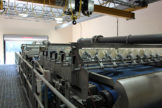
Global Sludge Dewatering Equipment Market Analysis, Drivers, Restraints, Opportunities, Threats, Trends, Applications, and Growth Forecast to 2028
-
10548
-
May 2023
-
153
-
-
This report was compiled by Kalyani Khudsange Kalyani Khudsange is a Research Analyst at Prudour Pvt. Ltd. with 2.5 years of experience in market research and a strong technical background in Chemical Engineering and manufacturing. Correspondence Sr. Research Analyst Linkedin | Detailed Market research Methodology Our methodology involves a mix of primary research, including interviews with leading mental health experts, and secondary research from reputable medical journals and databases. View Detailed Methodology Page
-
Global Sludge Dewatering Equipment Market Overview:
“The global Sludge Dewatering Equipment Market size is expected to be worth around US$ xx Billion by 2021 from US$ X.xx million in 2031, growing at a CAGR of X.x% during the forecast period 2021 to 2031.”
Sludge is nothing but soft, thick, wet mud. And, sludge dewatering is the process of removing or extracting water from this matter and the due disposal of the dewatered residue. Sludge dewatering is a means of treating sewage generated by the industrial and municipal sectors. It implements two methods of carrying out this treatment – centralized and decentralized. Examples of commonly used decentralized equipment are biofilters, septic tanks, aerobic treatment systems, etc. Centralized equipment can be found in piping and sewage systems.
Dynamics:
A brewing awareness of effective sludge treatment is one of the primary reasons for an increase in the demand for sludge dewatering equipment globally. Another reason that may help surge the demand for this equipment is the need to minimize the global water footprint and to yield optimum water quality across emerging economies in central & South America and the Asia-Pacific region as well.
The rise in mining activities due to adequate government support in developing nations such as Peru, Mexico, Chile, and South Africa is slated to play a crucial part in the growth of the global sludge dewatering equipment market over the forecast period.
Authorities such as Environmental Protection Agency (EPA), European Environment Agency (EEA), and the Central Pollution Control Board (CPCB) are presently playing a vital role in the prevention of water pollution and the improvement of the quality of water environments.
With growing populations, both urban and rural, there has been an increase in government support and investment to enhance infrastructure standards will give way to an expeditious surge of the global dewatering equipment market in the foreseeable future. The markets of Turkey, China, India, Thailand, and Bangladesh are expected to witness sharp growth.
Stringent regulations and guidelines that have been put in place by respective authorities (both in Europe and North America) will play their roles in boosting the economic reach of the global dewatering equipment market. Another factor that will prove to positively contribute to this industry’s growth is the evolution of technological advancements and innovations to sustain a competitive edge among industry players.
There are numerous applications in the industrial segment for raw and processed water in industries such as food & beverages, mining, refineries, paper & pulp, and pharmaceuticals among others.
With respect to the segmentation of the global dewatering equipment market on the basis of technology, the market is segmented into screw presses, centrifuges, and belt presses among others. The belt press technology segment with its low installation costs, high capacity output, continuous feed operation and low energy running costs are slated to grow extensively over the forecasted tenure.
Regional Analysis:
On the basis of region, this industry is sectioned into North America, Europe, Asia Pacific, Central & South America, and the Middle East & Africa. The Asian Pacific region is expected to have the largest demand for sludge dewatering equipment over the forecasted period. Increased industrialization, growth in infrastructure, and improvement in technological developments are resulting in the growth of the market. Local players in the Asia Pacific market also pose a threat to large corporations or multinational companies with regard to cost pricing and the quality of the product that is being offered to the consumer.
The Middle East and African regions are riddled with a large number of wastewater treatment plants thanks to the shortage of freshwater sources. The increasing per capita consumption of water paired with an ever-increasing population and a surge in the levels of immigration to this region will cause a spurt of growth in the sludge dewatering equipment market over the forecasted period.
Global Sludge Dewatering Equipment Market Segmentation:
Global Sludge Dewatering Equipment Market Segmentation, by technology:
- Belt press
- Screw press
- Centrifuges
Global Sludge Dewatering Equipment Market Segmentation, by end-use industries:
- Mining
- Food & beverages
- Refineries
- Paper & pulp
- Pharmaceuticals
Global Sludge Dewatering Equipment Market Segmentation, by Region:
- North America
- Europe
- Asia Pacific
- Central & South America
- Middle East & Africa
Attribute Report Details Market Size Ask For Market Size Growth Rate Ask For Growth Rate Key Companies Ask For Companies Report Coverage Revenue analysis, Competitive landscape, Key company analysis, Market Trends, Key segments, Distribution Channel, Market Dynamics, COVID-19 Impact Analysis and more… Historical Data Period 2015-2020 Base Year 2022 Forecast Period 2022-2031 Region Scope North America, Europe, Asia-Pacific, South America, Middle East & Africa Country Scope United States, Canada and Mexico, Germany, France, UK, Russia and Italy, China, Japan, Korea, India and Southeast Asia, Brazil, Argentina, Colombia etc.Saudi Arabia, UAE, Egypt, Nigeria and South Africa Revenue in US$ Mn -
-
- Suez Environnement
- Hitachi Zosen Corporation
- Evoqua Water Technologies
- Andritz, Inc.
- Keppel Seghers
- ENCON Evaporators
- Veolia
- Kontek Process Water Management
- Alfa Laval, Huber SE
- Flo Trend Systems
- Hiller Separation & Process
- Aqseptence
- Flottweg
- Komline-Sanderson




